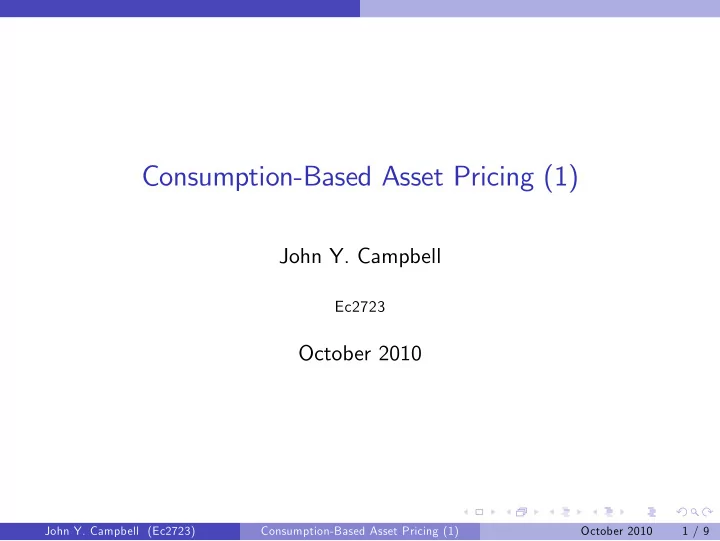

Consumption-Based Asset Pricing (1) John Y. Campbell Ec2723 October 2010 John Y. Campbell (Ec2723) Consumption-Based Asset Pricing (1) October 2010 1 / 9
Consumption-Based Asset Pricing CBAP is the attempt to relate stock prices to aggregate consumption, which determines marginal utility of a representative agent Equity premium puzzle : I Equity premium is high, which implies a volatile SDF. I But consumption is smooth, so we need high curvature of utility function to get volatile SDF. Equity volatility puzzle : Stock returns are much more volatile than consumption growth. Riskfree rate puzzle : High risk aversion to explain the equity premium puzzle makes real interest rate very high (or possibly very low!) and highly sensitive to parameters. John Y. Campbell (Ec2723) Consumption-Based Asset Pricing (1) October 2010 2 / 9
Campbell, “Consumption-Based Asset Pricing”, Handbook Chapter 2003
Power Utility Model Representative Agent, Power Utility Starting point is a representative agent with power utility: time discount factor δ and CRRA γ de…ned over aggregate consumption C t . U ( C t ) = C 1 � γ � 1 t . 1 � γ When γ = 1, U ( C t ) = log ( C t ) . Utility is scale-invariant, so risk premia do not alter with aggregate wealth given constant return distributions. Investors with di¤erent wealth but same CRRA have the same portfolio shares. The elasticity of intertemporal substitution or EIS, ψ , is the reciprocal of the CRRA γ . Epstein-Zin utility relaxes this restriction. John Y. Campbell (Ec2723) Consumption-Based Asset Pricing (1) October 2010 3 / 9
Power Utility Model SDF with Power Utility U 0 ( C t ) = C � γ t and the SDF is M t + 1 = δ ( C t + 1 / C t ) � γ . This is lognormal if consumption is. The log SDF is m t + 1 = log ( δ ) � γ ∆ c t + 1 . John Y. Campbell (Ec2723) Consumption-Based Asset Pricing (1) October 2010 4 / 9
Power Utility Model Asset Returns Under Lognormality Assume joint lognormality and homoskedasticity of asset returns and consumption. Expected returns are given by � 1 � [ σ 2 i + γ 2 σ 2 0 = E t r i , t + 1 + log δ � γ E t ∆ c t + 1 + c � 2 γσ ic ] . 2 Here σ 2 c denotes the unconditional variance of log consumption innovations Var ( c t + 1 � E t c t + 1 ) , and σ ic denotes the unconditional covariance of innovations Cov ( r i , t + 1 � E t r i , t + 1 , c t + 1 � E t c t + 1 ) . The riskfree rate is r f , t + 1 = � log δ + γ E t ∆ c t + 1 � γ 2 σ 2 c . 2 The risk premium on any other asset is E t [ r i , t + 1 � r f , t + 1 ] + σ 2 i 2 = γσ ic . John Y. Campbell (Ec2723) Consumption-Based Asset Pricing (1) October 2010 5 / 9
The Equity Premium Puzzle Equity Premium Puzzle Empirically, σ ic is low for stocks. Thus γ must be large to …t the high average returns on stocks. We can write the consumption covariance as σ ic = σ i σ c ρ ic , where ρ ic is the consumption correlation. Empirically, ρ ic is low but even if we set it to one we still do not bring γ down to a reasonable level. John Y. Campbell (Ec2723) Consumption-Based Asset Pricing (1) October 2010 6 / 9
The Equity Premium Puzzle Reactions to the Equity Premium Puzzle (1) Risk aversion is high. But this creates a riskfree rate puzzle because the average riskfree rate is E r f , t + 1 = � log δ + γ E ∆ c t + 1 � γ 2 σ 2 c 2 which is poorly behaved when γ is large. A con…dence interval for γ includes reasonable values. Average returns on stocks are overstated because I We ignore taxation (McGrattan and Prescott). I US returns were unusually high, or 20th Century returns were unusually high (peso problem, see Dimson, Marsh, and Staunton). John Y. Campbell (Ec2723) Consumption-Based Asset Pricing (1) October 2010 7 / 9
The Equity Premium Puzzle Reactions to the Equity Premium Puzzle (2) Consumption growth is not lognormal, and true expected returns are high because of a small probability of a disaster (Barro) or parameter uncertainty (Weitzman). The short-run covariance with consumption does not adequately represent long-run consumption risk because I There are adjustment costs in consumption (Gabaix-Laibson), or I Consumption growth has a persistent component and consumers have Epstein-Zin utility (Bansal-Yaron). John Y. Campbell (Ec2723) Consumption-Based Asset Pricing (1) October 2010 8 / 9
The Equity Premium Puzzle Reactions to the Equity Premium Puzzle (3) The representative agent model is ‡awed because I consumers have idiosyncratic, uninsurable labor income risk I not all consumers participate in the stock market I some consumers are borrowing constrained. The power utility model does not adequately represent preferences. Alternatives: I Epstein-Zin utility I Habit formation utility (Constantinides, Campbell-Cochrane). John Y. Campbell (Ec2723) Consumption-Based Asset Pricing (1) October 2010 9 / 9
Recommend
More recommend